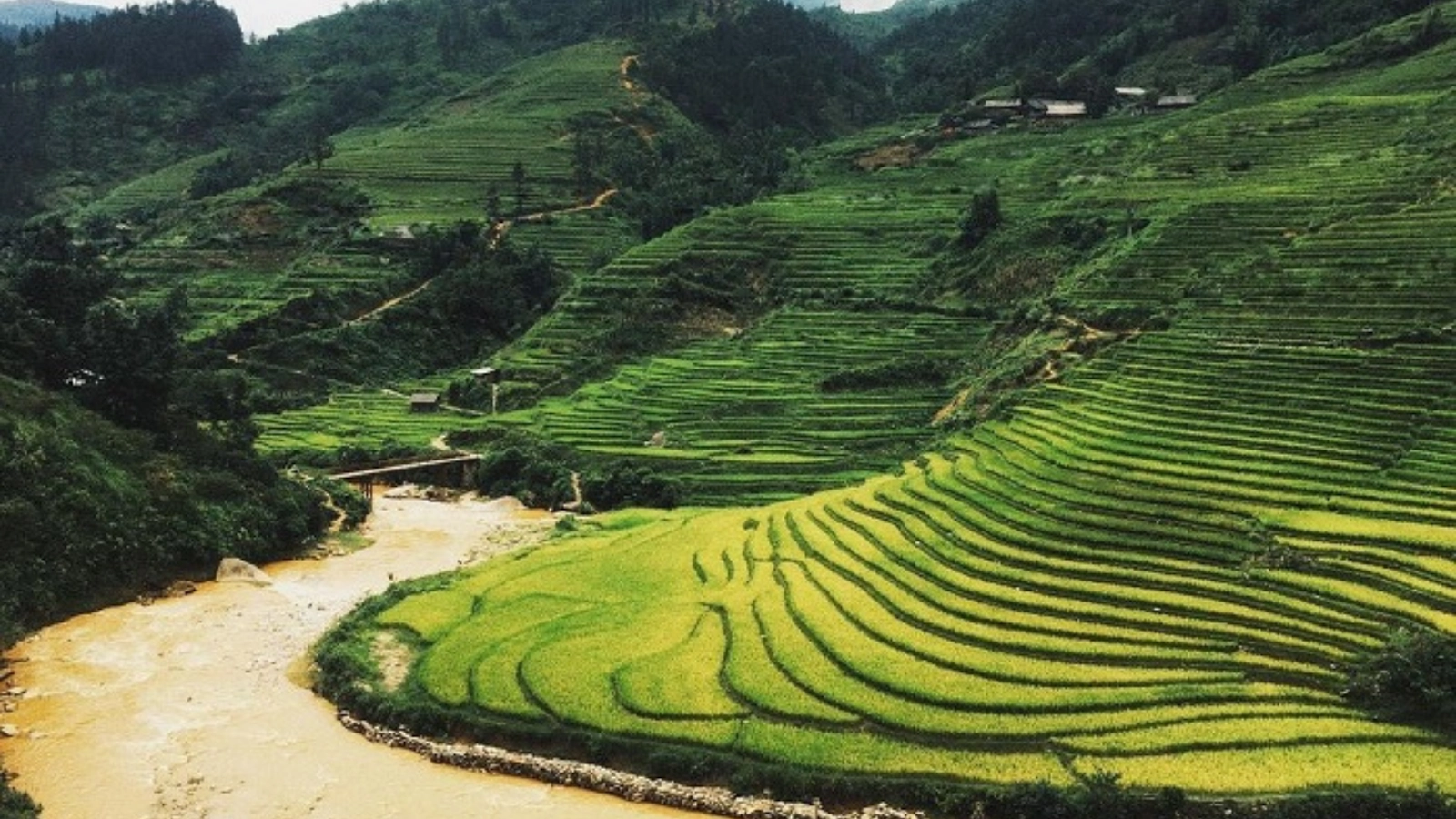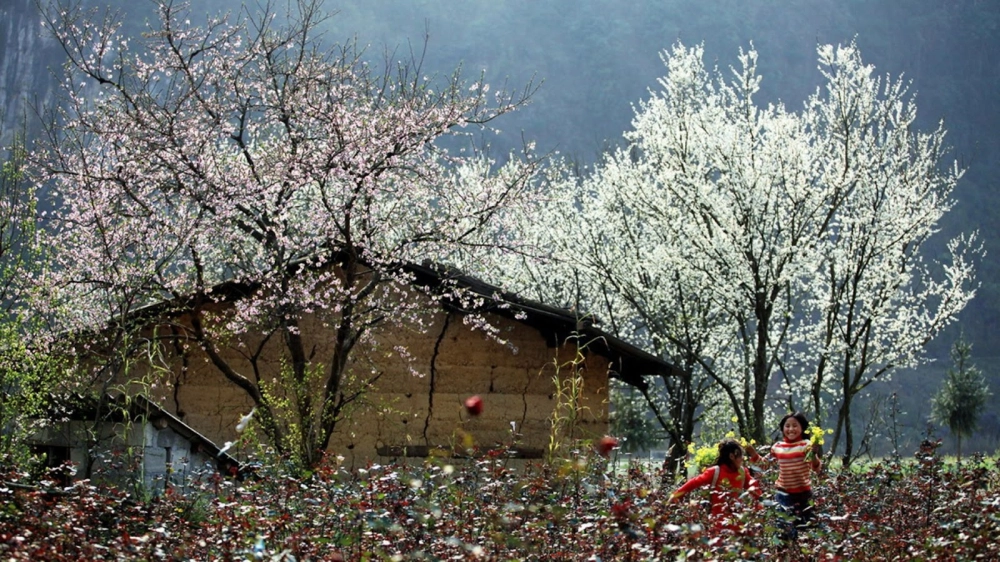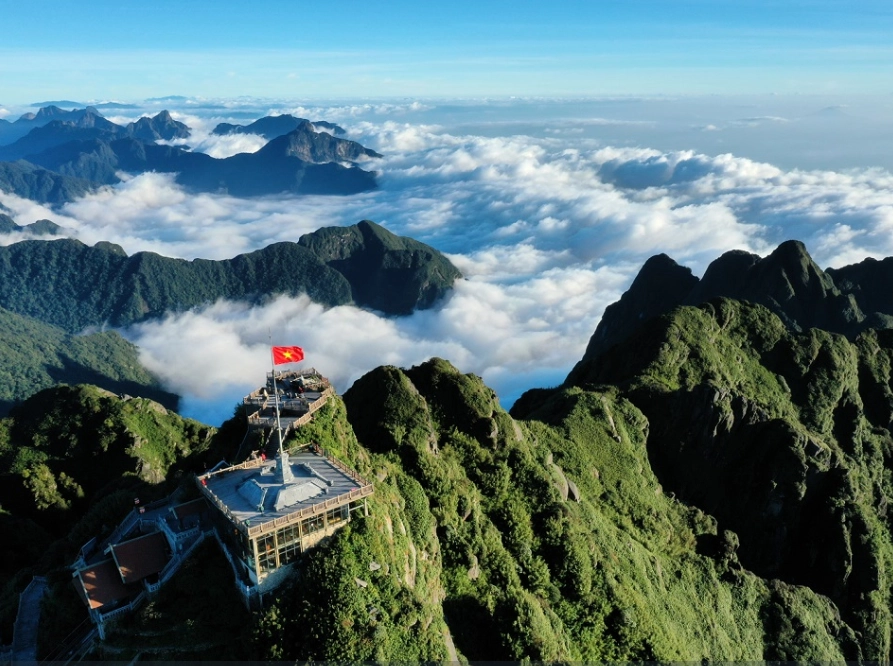1. Introduction to Sau Chua Village (Sa Pa)
Sau Chua Village (Sa Pa) is gradually becoming a destination attracting a large number of tourists who love exploration, and especially for those passionate about cloud hunting, seeking lands that retain their rustic beauty. With its prominent location on the mountaintop, the climate is always cool and pleasant, making it an ideal resting spot, helping you temporarily escape the bustling city life.

Sau Chua Village Sa Pa - simple beauty amidst the colorful culture of the highlands. (Source: Collected)
1.1. Geographical location, route, and characteristic climate
Sau Chua Village is located in Sa Pa ward, Lao Cai province, some distance from the center. Situated at an altitude of 1,700 m, the village is surrounded by weathered limestone mountains and deep valleys nestled amidst large forests.
To get to Sau Chua Village (Sa Pa), you travel along Dien Bien Phu street towards Sa Pa to Lao Cai. At km32, you will see a sign indicating a right turn into the village. The road leading to the village, although winding, has been solidly concreted, suitable for most types of vehicles.
The climate here is always cool. In winter, the temperature sometimes drops below 0°C and frost appears. The air is fresh, with thick fog year-round and a sea of clouds covering the landscape, creating a mystical scene characteristic of the high mountainous temperate climate of the Northwest.
1.2. What makes Sau Chua Village (Sa Pa) different?
Sau Chua Village Sa Pa is often referred to as Sa Pa's "cloud hunting paradise" due to its high altitude and minimal impact from tourism activities. White seas of clouds often appear in the early morning, enveloping the village and creating a "mid-cloud" space, attracting young people passionate about exploration and photography.
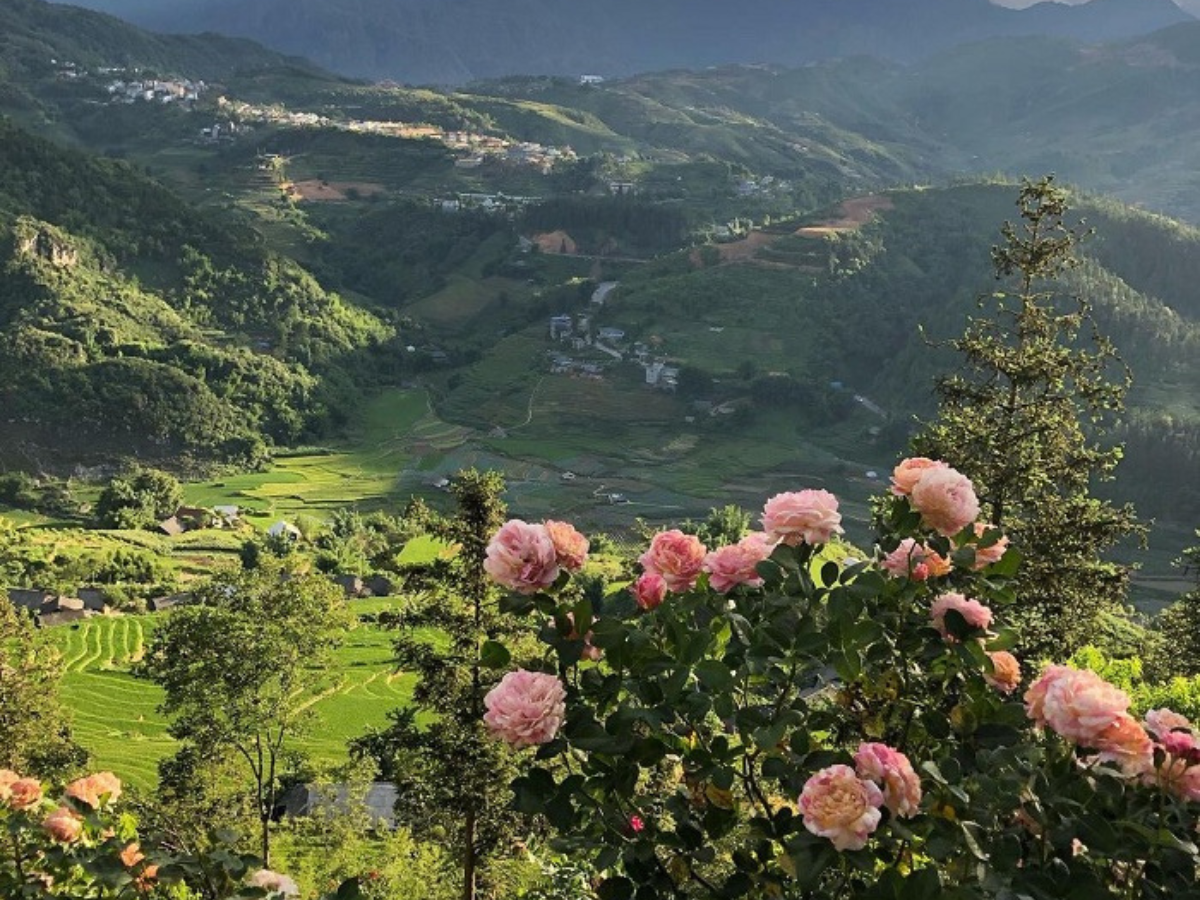
Ban Sau Chua - where white clouds embrace vibrant flower slopes. (Source: Collected)
Amidst this scenery, the 8-hectare flower garden unfolds like a vibrant painting. Depending on the season, it changes its attire: sometimes old roses show off their colors, other times pear blossoms, peach blossoms, and bright yellow mustard flowers cover the entire hillside. Interspersed among these color patches are lush green terraced fields winding around the village, making everyone pause for a moment to admire.
What makes Ban Sau Chua even more special is the feeling of untouched authenticity that is perfectly preserved. No noisy stalls, no bustling crowds, just simple wooden houses, kind Mong people, and a slow, peaceful way of life. If you are looking for a place to escape the hurried pace of life, to breathe in the fresh air, and to listen to the gentle sounds of the mountains and forests, then Ban Sau Chua is the perfect stop.
2. Traveling to Ban Sau Chua (Sapa): A Detailed A to Z Guide
Choosing the right mode of transport will make your trip to Ban Sau Chua more complete and safer. Although the distance is not too far, the winding mountain passes require careful preparation before departure.
Motorbikes are the most popular choice among young travelers. Rental prices range from VND 120,000–150,000 per day, which is reasonable and extremely flexible. You can stop anywhere you like to take photos of flying clouds, admire the terraced fields, or simply breathe in the fresh mountain air. However, make sure you are familiar with riding on mountainous terrain, and check your brakes and tires thoroughly before setting off to ensure safety.
If you are traveling with family or want a more relaxed journey, an electric car is a sensible option. Rental prices range from VND 200,000–300,000 per day, they are eco-friendly, operate smoothly, and are especially suitable for children or the elderly. The feeling of gliding slowly amidst the sound of the wind and rustling leaves is also a very worthwhile experience.
Additionally, taxis and ride-hailing motorbike taxis are quite common in the center of Sapa, with prices around VND 150,000–200,000 per one-way trip. If you plan to return on the same day, it is advisable to negotiate with the driver beforehand to have them wait.
A small note: the road to Ban Sau Chua has many sharp turns and steep inclines. Especially on cold days or when there is fog, visibility will be limited. Therefore, you should not travel too late, remember to dress warmly, turn on your headlights, and maintain a safe distance. Before you go, ask locals about the weather conditions; just a few minutes of preparation can make your journey much safer and more complete.
3. Outstanding Experiences at Ban Sau Chua (Sapa)
3.1. Hunting the Sea of Clouds at Ban Sau Chua
The sea of clouds at Ban Sau Chua (Sapa) forms due to the temperature difference between day and night, causing water vapor to condense into a layer of fluffy white clouds covering the valley. This phenomenon is most prominent at dawn, from 5 AM to 8 AM, when the early morning sun filters through the clouds, creating a magical scene like a fairyland.
The ideal season for "cloud hunting" is from October to March of the following year, when the weather is dry and cold, humidity is high, and the clouds are thicker and more persistent. After light rains, the clouds become even more voluminous, creating a scene akin to a celestial realm.
The best spot for viewing clouds is the peak of the central hill of the village – where you can take photos on the rocks along the valley edge while admiring the rolling sea of clouds below. The flower garden at Ban Sau Chua is also another ideal location, where the vibrant colors of the flowers blend with the leisurely clouds in the distance, creating a frame that is both poetic and unique.
3.2. Exploring the Flower Garden at Ban Sau Chua: Old Roses, Pears, Peaches, Mustard Flowers
Spanning an area of 8 hectares, the flower garden at Ban Sau Chua is considered the largest flower garden in the Sapa region, gathering countless flower species characteristic of the highlands. Each species is planted in separate zones, creating a multi-layered tapestry of colors stretching along the hillsides.
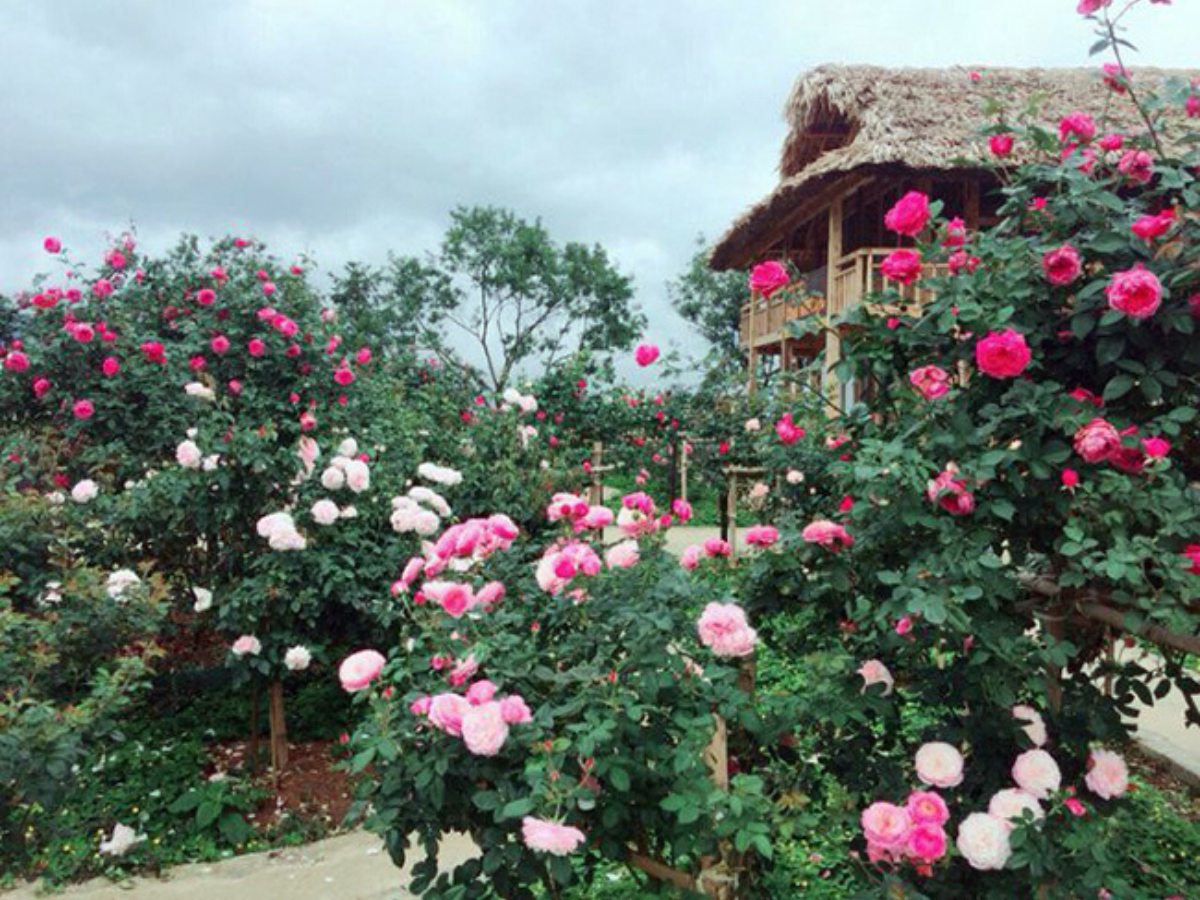
The old rose garden in Ban Sau Chua is showing off its colors amidst the morning mist. (Source: Collected)
The most outstanding are the precious old rose bushes, with varieties imported from Europe, blooming in spring and autumn, emitting a gentle yet captivating fragrance. From February to April, pear blossoms and peach blossoms bloom together, covering the hills with a delicate layer of "white snow". By November–December, yellow mustard flowers take the spotlight again, dyeing the entire space yellow, turning this place into a perfect background for virtual photos.
Visitors can freely stroll, take photos, and listen to locals talk about how to grow and care for each type of flower. During the peak blooming season, the village also organizes flower festivals, cultural performances, and introduces traditional cuisine, offering an authentic Mong cultural experience amidst the Northwest mountains.
3.3. Admire terraced fields and unique check-in stone beaches
When mentioning the Northwest, one must mention terraced fields, and in Ban Sau Chua, that image is vividly and enchantingly recreated. Each plot of rice fields winds around the mountainside like steps leading up to the clouds.
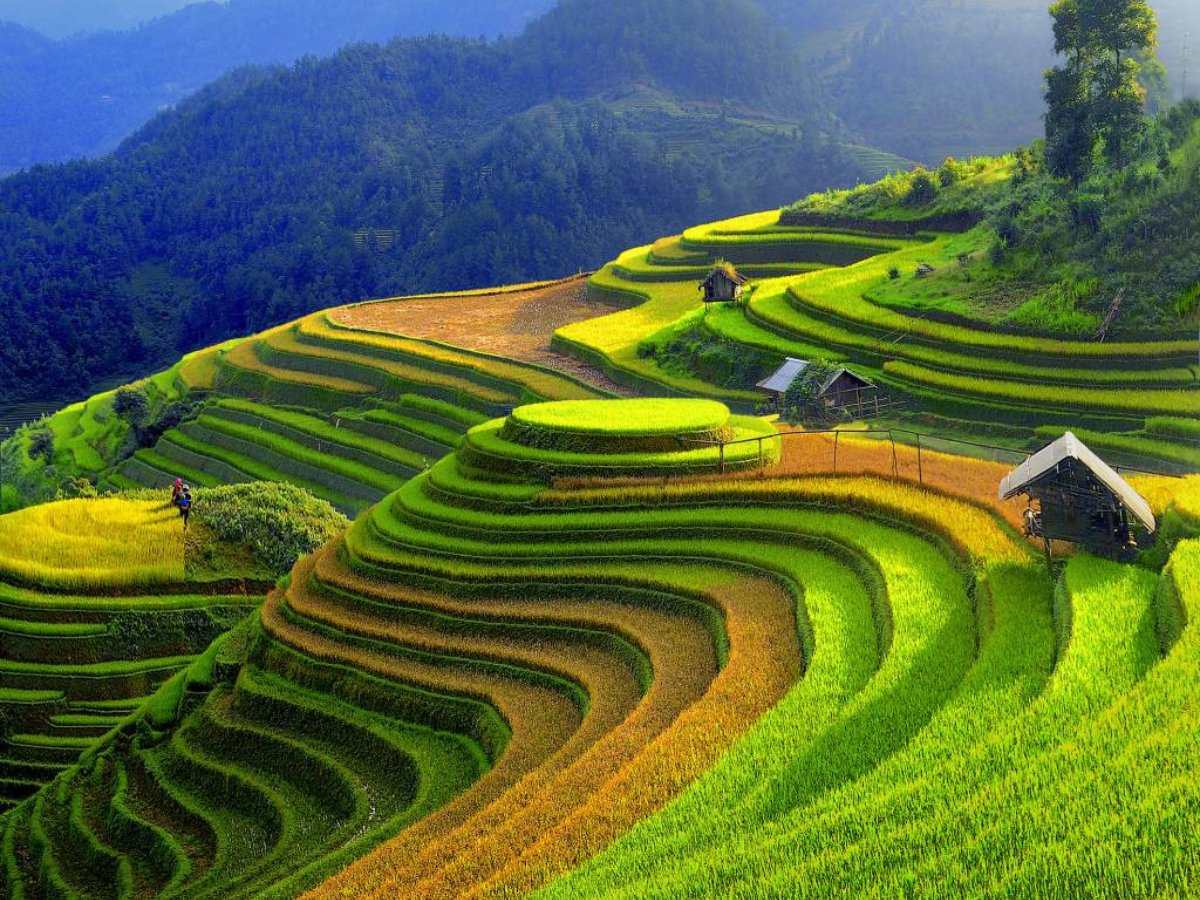
Terraced fields in Ban Sau Chua shimmer in the early mountain sun. (Source: Collected)
From May to September, the fields are covered in a lush green color. When harvest season comes, from September to October, the rice ripens to a golden yellow, and a fragrant aroma spreads throughout the village - this is also the most beautiful time for photographers to "hunt" for golden moments of the harvest.
In addition, Ban Sau Chua also has an extremely impressive check-in stone beach on the edge of the valley. Large rocks have peculiar shapes, among which the heart-shaped stone is prominent. This is a meeting place for couples and for romantic sunset photos. From here, you can gaze into the distance and see clouds floating dreamily amidst the rolling mountains.
3.4. Experience local culture and ancient architecture
Visiting Ban Sau Chua, tourists not only admire the scenery but also touch the real life of the Mong people - simple, slow, and full of human warmth. You can join the locals in tending flowers, harvesting vegetables, or try weaving brocade - a traditional craft that has existed for generations.
Mong women diligently weave fabric on wooden looms, using natural dyes from forest leaves and fruits to create patterns with unique meanings. They are willing to share stories about each motif, each piece of fabric, helping tourists better understand the soul of the highland people.
The ancient Mong houses here are also a "living museum" with yin-yang tiled roofs, rammed earth walls, and hand-stacked stone fences. This structure not only keeps warm in winter and cool in summer but also reflects the harmony between humans and nature.
In the quiet space of the village, sitting and enjoying tea by the fire, listening to the elders tell old stories, you will feel more clearly the true, profound, and rich beauty of Ban Sau Chua - a place where sky and clouds blend poetically with human life.
4. Must-try local cuisine in Ban Sau Chua, Sa Pa
4.1. Sau Chua My Tuu Wine: Essence of the mountains
Sau Chua My Tuu wine is a proud specialty of Ban Sau Chua (Sa Pa), with a secret passed down through generations. The main ingredient is high-quality mountain rice, grown on terraced fields without the use of chemical fertilizers.
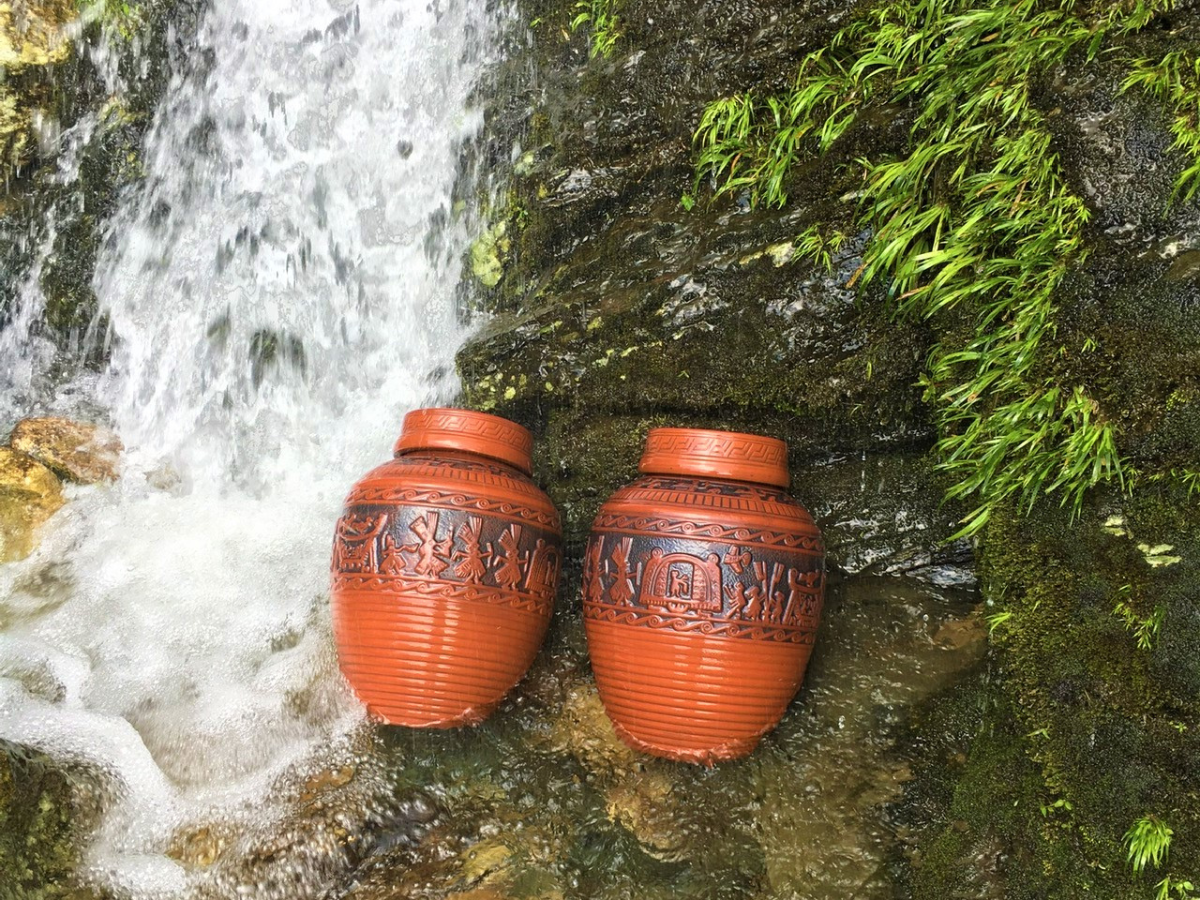
Ban Sau Chua fermented rice wine jar - the intense flavor of the Northwest mountains and forests. (Source: Collected)
Traditional leaf yeast is made from many types of forest leaves, then dried, roasted, and ground. The fermentation process lasts from 3 to 6 months in earthen jars, creating a rich, characteristic aroma. Besides, locals also utilize fruits such as plums, wild pears, and hawthorn apples to make a more diverse range of fruit wines.
Sau Chua wine is lightly fragrant, slightly spicy, with a delicate sweet aftertaste, harmonizing with the cold climate here. The alcohol content is about 25 to 30 degrees, suitable for enjoying with mountain forest dishes or as a gift for loved ones after the trip.
4.2. Highland specialties: thang co, nam pia, local pork, wild vegetables
Thang co is the most prominent traditional dish, prepared from horse or buffalo offal along with characteristic spices such as mac khen leaves, ginger, and wild mountain chili. The rich, slightly spicy flavor is especially suitable for enjoying in the cold weather with friends and family during festivals.
Nam pia is a unique stream fish salad, made with fresh fish caught from the streams in the village, prepared with many herbs, wild chili, lime, and fish sauce. The fresh, sour, and spicy taste of nam pia is very suitable when immersed in the cool atmosphere of Ban Sau Chua (Sa Pa).
Highland local pork is famous for its firm, naturally sweet meat, as the pigs are free-range, feeding on grass and forest fruits. The most popular preparations are grilled, smoked, or cooked with wild vegetables, creating dishes that are both fragrant and appealing.
Wild vegetables in Ban Sau Chua (Sa Pa) are diverse, including bitter vegetables, chayote, bamboo shoots, fig leaves, and many other local vegetables. The vegetables are simply prepared by boiling, making soup, or dipping with traditional soy sauce, retaining their natural deliciousness and being nutritious.
5. Suggested itinerary for exploring Ban Sau Chua Sa Pa 3 days 2 nights
- Day 1: Check-in Ban Sau Chua: Stroll through flower gardens, admire terraced field sunsets
In the morning, depart from Sa Pa center to Ban Sau Chua, taking only about half an hour to travel. After checking into a homestay or local hotel, you can spend time visiting the flower gardens. Every corner is a beautiful background for those who love photography and nature.
The afternoon is the ideal time to stroll among the winding terraced fields, or check in at the famous stone field on the edge of the valley. Under the sunset, the mountain scenery is covered in a soft golden hue, as if touchable. When dusk falls, enjoy a cozy dinner with local specialties such as grilled local pork, stir-fried wild vegetables with garlic, and Sau Chua wine with the villagers.
- Day 2: Cloud hunting, experiencing Mong culture, and conquering Fansipan
Set your alarm very early, around 4:30 AM, to prepare for the cloud hunting journey. From 5 AM to 8 AM, the dawn light pierces through the fluffy clouds, illuminating the entire valley, bringing a feeling of peace and awe.
After breakfast, you can visit ancient Mong houses, try weaving brocade, or listen to the elders tell stories about the village's history. These experiences help you understand more about the cultural life and the dexterity of the highland people.
After lunch, visit Sun World Fansipan Legend, take the cable car to admire the clouds and check in at Fansipan peak. Returning to Ban Sau Chua in the evening, listening to the chirping of insects by the porch, will be the perfect way to end the day.
- Day 3: Explore the market – Buy souvenirs and say goodbye to Ban Sau Chua
On your last morning, don't rush to leave. Take time to wander around the village market, where handmade brocade, Sau Chua wine, forest honey, and dried flowers are sold – souvenirs that carry the soul of the Northwest.
Before leaving the village, take the opportunity to take a few more souvenir photos amidst the flower gardens, terraced fields, or the cloud-hunting stones. In the afternoon, depart back to Sa Pa center, concluding a 3-day journey full of memories – where the sky, people, and nature blend together peacefully and unforgettably.
6. Travel tips for Ban Sau Chua (Sa Pa)
To make your trip to Ban Sau Chua (Sa Pa) complete, you should pay attention to preparing your luggage, choosing the right time, and observing local customs.
Clothing is essential; remember to pack a warm jacket even if traveling in summer, as the nights can be quite cold, possibly below 15°C. Don't forget to bring a scarf, gloves, and a woolen hat in the cold season. Low-heeled, non-slip sports shoes will help you move easily on mountain paths and wet rocky areas.
October to March is the ideal time for cloud hunting; February to April are highlighted by pear and peach blossoms; November to December is when yellow mustard flowers cover the hillsides. Each season is beautiful, but you should pack appropriately for the temperature at that time.
Respecting local customs is a priority. Ask for permission before photographing children or entering private living areas. Dress modestly, avoiding overly revealing clothing, to show respect for the Mong culture. Always keep the landscape clean and protect the environment for future generations.
Ban Sau Chua (Sa Pa) proves that the traditional, pristine beauty of nature and ethnic culture still holds a prominent appeal in the new era. It is not only a resort destination but also a place to reconnect with nature and yourself. Don't forget to pack your bags to explore Ban Sau Chua (Sa Pa) and experience memorable moments amidst the mystical sea of clouds and vibrant blooming flowers!




